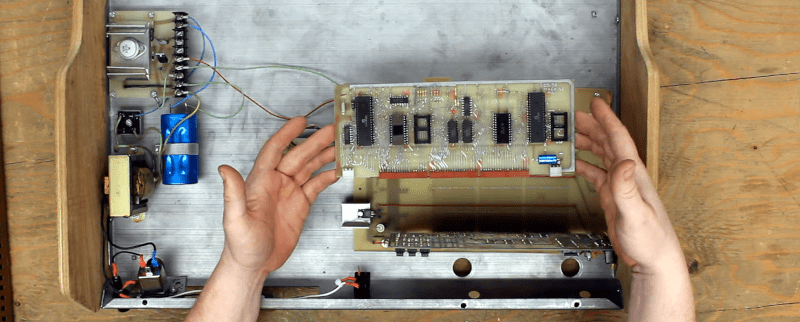Mystery 1802 Computer Was a Homebrew Project

[CelGenStudios] has an impressive collection of vintage hardware. One that really struck us came from a thrift store in Canada, so the original provenance of it is unknown. It looks like someone’s handmade interpretation of a SOL-20. There’s a wooden and sheet metal box containing a keyboard looted from an old dedicated word processor (back when a word processor was a machine, not a piece of software). Inside? Some vintage-looking hand-drawn PC boards, including a backplane with two boards. One contains an RCA 1802 and a little bit of memory. There’s also a video card with more memory on it than the CPU.
We loved the 1802, and we disagree with [CelGenStudios] that it “wasn’t that popular.” It was super popular in some areas. The CMOS processor was popular in spacecraft and among homebrew builders. There were a few reasons for that. Unlike some early CPUs, you didn’t need much to bootstrap a system. It would run on 5V and had a “DMA” mode to key data in with just a few simple switches and buttons. You didn’t need a ROM-based monitor to get the system to work. In addition, the design could be low power, and the static design meant you could slow or stop the clock for very low power compared to many other systems of the day.
Inside the box was also a tiny board that was a mystery. That is until he noticed that it had a connector that would fit a Commodore cassette deck. The keyboard cable needs rewiring, but otherwise, the machine works. There is a ROM with a monitor since the DMA mode wouldn’t understand the video and keyboard.
The real mystery is who made this computer and why? It seems like it might have been a prototype for a failed business. Or perhaps it was just a labor of love from someone with a lot of talent. If this computer looks familiar to you, he’d love to hear from you.
The 1802 had a very logical instruction set thanks to being the design of one person, [Joe Weisbecker]. You can still build a simple computer using one. Of course, you can also emulate it with an Arduino.
Thanks [Stephen Walters] for the tip!
Post a Comment